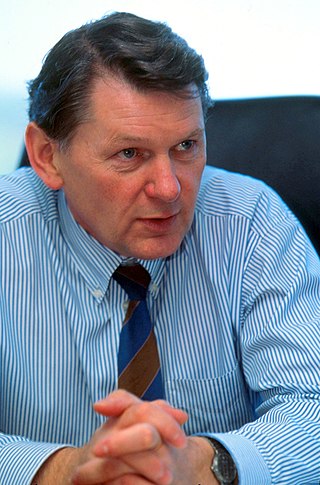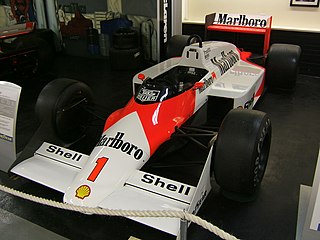Neil Oatley | |
|---|---|
| Born | 12 June 1954 |
| Nationality | |
Neil Oatley (born 12 June 1954) is a British design and development director in Formula One teams.
Neil Oatley | |
|---|---|
| Born | 12 June 1954 |
| Nationality | |
Neil Oatley (born 12 June 1954) is a British design and development director in Formula One teams.
Born in Britain, Oatley graduated from Loughborough University in 1976 with an automotive engineering degree. He worked briefly outside motor racing before joining the Williams team in 1977. There he became one of many young engineers to have worked alongside Patrick Head early in their careers before moving on to other organisations. Oatley worked as a draughtsman before becoming a race engineer for both Clay Regazzoni and Carlos Reutemann.
In 1984 Oatley was recruited by Carl Haas to work on the FORCE F1 project, but the results were poor, and the team withdrew from Formula One in 1986.
Oatley joined the McLaren team shortly after leaving FORCE and worked alongside John Barnard in the design office. After Gordon Murray replaced Barnard as technical director, Oatley was put in charge of the design of the naturally aspirated car for 1989—Steve Nichols having been appointed chief designer of the 1988 chassis—and remained chief designer after Murray moved to the new McLaren road car project. His cars secured titles in 1989, 1990, 1991, 1998 and 1999.
Oatley continued to work as chief designer at McLaren until 2003, when he became executive director of engineering.
Sir Patrick Michael Head, FREng is a British motorsport executive who is the co-founder and former Engineering Director of the Williams Formula One team. For 27 years from 1977 Head was technical director at Williams Grand Prix Engineering, and responsible for many innovations within Formula One. Head oversaw the design and construction of Williams cars until May 2004 when his role was handed over to Sam Michael.
Ian Gordon Murray, is a South African-British designer of Formula One racing cars for Brabham and McLaren and the McLaren F1 high-performance road car. Founder and CEO of Gordon Murray Design and Gordon Murray Automotive he has subsequently designed and built a number of sports cars and a variety of other automotive vehicles.

John Edward Barnard, is an English engineer and racing car designer. Barnard is credited with the introduction of two new designs into Formula One: the carbon fibre composite chassis first seen in 1981 with McLaren, and the semi-automatic gearbox which he introduced with Ferrari in 1989.

Adrian Martin Newey, is a British Formula One engineer. He is the chief technical officer of the Red Bull Racing F1 team. Newey has worked in both Formula One and IndyCar racing as a race engineer, aerodynamicist, designer and technical director and enjoyed success in both categories.

Harvey Ernest Postlethwaite was a British engineer and Technical Director of several Formula One teams during the 1970s, 1980s and 1990s. He died of a heart attack in Spain while supervising the testing of the aborted Honda F1 project.

The McLaren MP4/5, and its derived sister model, the McLaren MP4/5B, were highly successful Formula One racing cars designed by the McLaren Formula One team based in Woking, England, and powered by Honda's naturally-aspirated RA109E and RA100E V10 engines respectively. The chassis design was led by Neil Oatley, teaming up with Steve Nichols, Pete Weismann, Tim Wright, Bob Bell and Mike Gascoyne. As with the previous designs, Gordon Murray, as Technical Director, had the role of liaising between the drawing office and production. Osamu Goto was the Honda F1 team chief designer for the car's engine.

The McLaren MP4/1 was a Formula One racing car produced by the McLaren team. It was used during the 1981, 1982 and 1983 seasons. It was the second Formula One car to use a monocoque chassis wholly manufactured from carbon fibre composite, after the Lotus 88, a concept which is now ubiquitous. The MP4/1 was first entered in a Formula One race at the third grand prix of the season in Argentina.
Michael Coughlan is a British motor racing engineer and designer. He was Chief Designer for the McLaren Formula One team from 2002 to 2007, where he was suspended for his part in the spygate scandal between McLaren and Ferrari, before his contract was subsequently terminated. He was then Chief Technical Officer for Williams F1 from June 2011 to July 2013, before abruptly stepping down "with immediate effect," according to the team.
Nikolas Tombazis is a racing car designer who has worked in Formula One since 1992 for the Benetton, McLaren, and Ferrari teams.
Team Haas (USA) Ltd., sometimes called Beatrice Haas after its major sponsor, was an American Formula One team founded by Carl Haas in 1984 after an agreement with Beatrice Foods, a US consumer products conglomerate, which competed in the World Championship from 1985 to 1986. An agreement to use Ford engines for three seasons faltered after a change of management at Beatrice. The firing of Beatrice CEO Jim Dutt led to Beatrice withdrawing their funding of the project. The team was unable to continue in Formula One after the 1986 season. 1980 World Champion Alan Jones was coaxed out of retirement to drive the team's first car at the end of the 1985 season and on into 1986.

The McLaren MP4/3 was the car with which the McLaren team competed in the 1987 Formula One World Championship. The car was designed under the leadership of long-time McLaren engineer Steve Nichols, in collaboration with Neil Oatley, Gordon Kimball, Tim Wright and Bob Bell. It was also the last McLaren car to be powered by the TAG-Porsche turbo engine that had been introduced in 1983. The car was driven by double World Champion Alain Prost, in his fourth season with the team, and Stefan Johansson, who moved from Ferrari.
Frank Coppuck is a British engineer and racing car designer, who helped design the Pacific PR01 and PR02 Formula One cars.

Patrick Fry is a British motorsports engineer. Primarily working in Formula One, he has previously held positions with the Alpine, McLaren, Ferrari, Manor Racing, and Benetton teams. As of 2023, Fry is the Chief Technical Officer for Williams Grand Prix Engineering.

Robert John "Robin" Herd was an English engineer, designer and businessman.
Stephen Anderson Nichols is an American engineer who is best known as a car designer for many Formula One teams from the mid-1980s until 2001.

Jonathan Neale is a British businessman and the chief operating officer of McLaren Group. Neale's responsibilities as part of the executive management team include infrastructure development, information technology, facilities management as well as holding a number of statutory directorships.
Diane Holl is a British engineer who has worked in Formula One, Championship Auto Racing Teams (CART), and NASCAR. She is employed at the Hendrick Motorsports NASCAR team as director of vehicle engineering.
Rob Marshall is a British Formula One engineer. He had a leading role in the Red Bull Racing team since 2006, and will be joining the McLaren team in a senior technical role on 1 January 2024.
Luca Furbatto is an Italian Formula One engineer. He is currently the engineering director at the Aston Martin Formula One team.
Henri Durand is a French race car engineer who worked for several Formula One teams from 1985 to 2004.